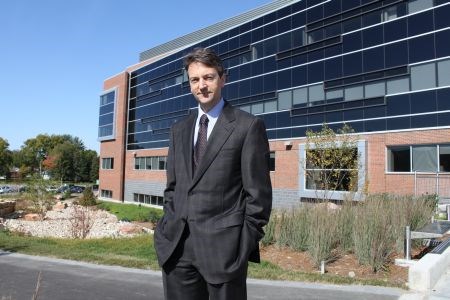Two years after it broke ground on the Algoma University campus, the new Biosciences and Technology Convergence Centre is living up to its name as science, technology, academia and private enterprise converge to create economic development opportunities for the Sault.
An official opening will take place this fall, but tenants began moving in this summer, and Algoma University president Richard Myers is enthusiatic about the possibilities it presents.
“It’s a very exciting kind of place, and we have very high hopes that it will allow us to make a very strong contribution to the development of the Sault Ste. Marie economy in a new technology-focused direction,” he said, noting that renewable energy and economic development also tie into the mandate.
Anchoring the building is the Sault Ste. Marie Innovation Centre and its business incubator, along with the Community Geomatics Centre, Algoma Games for Health, the Health Informatics Institute, and the Invasive Species Research Institute. State-of-the-art science labs for Algoma’s science students have also been incorporated into the facility to complement a quintet of full-time science faculty that have been hired within the last few years.
“We have beautiful new science facilities and fantastic new science professors, and I think our science programming is probably very quickly going to become the most successful part of the university,” Myers said.
For Tom Vair, executive director at the innovation centre, the new, spacious building has fulfilled a need for additional capacity. Partnerships have been key to many of the centre's initiatives and the new space should only improve those relationships.
“At the end of the day, the whole thing is really just about trying to grow jobs and activity in the science and technology sector so we can bring back more talented young people to Sault Ste. Marie, or help them stay here, or attract new companies here,” Vair said.
Four companies have moved into the incubator at the new building since August, and Vair anticipates they will soon reach capacity, but conceded “those are good challenges to have.”
One of the centre’s most recent initiatives was the successful implementation of Soo Sustainable, a seven-day series of activities and workshops that focused on renewable energy. Designed to provide information on the benefits of a sustainable community that includes renewable energy, the event complemented the city’s work to develop a Community Sustainable Energy Strategy.
“One of our goals was to use this event to engage people. We ran a specific session on the Community Sustainable Energy Strategy, asking people to come out and provide their input,” Vair said. “The consultants presented some initial thoughts they had for the strategy and I think got some really valuable feedback on those thoughts and ways to refine it and improve it.”
That feedback will be weighed, and the consultants are expected to return with a draft policy by Nov. 15, after which it will be presented to city council for consideration.
As the innovation centre builds on its success, the university, too, is celebrating its achievements, particularly in its science programming. Before now, the school was without its own science labs, and its students used labs in the city’s two government forest research institutes for their studies.
With new labs, new professors and a new biology degree program introduced last year, Myers has seen application numbers for the biology program jump, particularly amongst local students. He believes students were reticent to study science at Algoma in the past because of the lack of facilities, but that’s not a hindrance anymore.
The university is embarking on a new marketing campaign that touts the benefits of attending a small university—smaller class sizes, private rooms, and opportunities for research and publishing among them.
“I think, in the past, we’ve been a little apologetic about it,” Myers said. “The message was, ‘We hope, in 20 years, to be almost like other universities,' and I think that really short-changed the strengths of the institution, which are very substantial.”
Myers said while attracting out-of-region and international students is part of its mandate, ultimately the school’s goal is to create educational opportunities for Saultites so they can help enrich and enhance the fabric of the city.
“Our programming base is designed to serve them and the broader community,” he said. “We need to have academic programming that Sault Ste. Marie needs in order to move forward economically and socially.”




